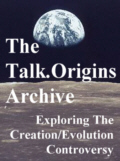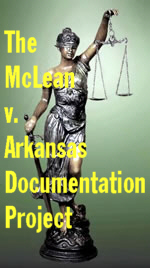
Troy Britain's
Creation/Evolution
Locus
Consider helping me defend science education by making a donation.
Thank you.
Just what DO they say Dr. Morris?
By Troy Britain
©
1999
An earlier version of this article appeared in the Reports of the National Center for Science Education, vol. 19 No. 1 Jan./Feb. 1999.
Spanish language version translation by Hernán Toro.
![]()
![]() he March 1999
issue of Back to Genesis, written by Institute for Creation Research
President Emeritus, Henry Morris, was titled
What They Say.
As one
might guess from such a title, it was yet another example of a creationist
attempting to use evolutionists own words to criticize evolutionary theory.
This is a tactic that those of us who follow creationist arguments are all too
familiar. Often, such quotes of mainstream scientists given by creationists are
not what they are represented to be. Knowing this, I read the article with a
wary eye. My skepticism was vindicated when I happened upon the following:
he March 1999
issue of Back to Genesis, written by Institute for Creation Research
President Emeritus, Henry Morris, was titled
What They Say.
As one
might guess from such a title, it was yet another example of a creationist
attempting to use evolutionists own words to criticize evolutionary theory.
This is a tactic that those of us who follow creationist arguments are all too
familiar. Often, such quotes of mainstream scientists given by creationists are
not what they are represented to be. Knowing this, I read the article with a
wary eye. My skepticism was vindicated when I happened upon the following:
There are no evolutionary transitions fossilized
anywhere, although billions of fossils are there still preserved in the rocks.
One of the outstanding problems in large-scale
evolution has been the origin of major taxa, such as the tetrapods, birds, and
whales, that had appeared to rise [sic] suddenly, without any obvious answers
[sic], over a comparatively short period of time.
Professor Carroll, an eminent Canadian
paleontologist, is well aware of such highly publicized fossils as archaeopteryx
(the alleged half-reptile, half-bird) and the so-called walking whale, but he
still has to acknowledge that birds and whales arose suddenly without obvious
ancestors (Morris 1999: b).
What first made me suspicious about this was the past tense of the sentence
("had appeared") that Morris quoted. Secondly I knew that the
implication that Morris was proposing from the quote simply wasn't true, and
given my understanding that Robert Carroll is a competent paleontologist, I
suspected something might be wrong. So I looked up the context. The text
selected by Morris for quotation is indicated in italics.
"Is macroevolution conceptually different than
microevolution? The main driving forces are the same as at the species level:
population growth, genetic variation, and behavioral plasticity. At both time
scales, external factors of the biological and physical environment control the
rate, scope, and direction of change.
One of the outstanding problems in
large-scale evolution has been the origin of major taxa, such as the tetrapods,
birds, and whales, that had appeared to arise suddenly, without any obvious
ancestors, over a comparatively short period of time. Increased
knowledge of the fossil record has greatly
increased our understanding of these and other transitions, and show that they
do not necessarily require processes that differ from those known to occur at
much lower taxonomic levels…From examples considered in this text, it can be
seen that adaptive change, morphological change, and radiation can be decoupled
in that each may occur at a different time. We now see that the overall rate of
evolution is not greatly faster during the origin of a group than it is within
the ancestral or the descendant lineages, and with the discovery of
intermediate forms, we see that they are not necessarily any more poorly
represented in the fossil record than single lineages might be at other stages
of evolution (Carroll 1997: 391).
Not only does the very next sentence in the paragraph contradict Morris's
implication but a few sentences later Carroll specifically refers to the
existence of intermediate forms and explicitly states that the evolution of
higher taxa did not occur at a different rate than that of groups at lower
taxonomic levels. Even if one were to disagree with Carroll about the facts of
the matter, it is clear from the context that Carroll is saying the very
opposite of what Morris implied he was saying.
Morris also refers specifically to Archaeopteryx and the evolution of
birds. What does Carroll say about avian origins in the very book that Morris
is quoting from above:
Despite the enormous gap in anatomy, physiology, and
way of life between modern birds and the other long-recognized vertebrate
classes, the fossil record provided singularly informative evidence of the
origin of birds long before we understood the ancestry of tetrapods, amniotes,
or mammals. Historically, the question of the origin of birds has concentrated
on a single genus, Archaeopteryx from the Upper Jurassic, which appears
as an almost ideal intermediate between "reptiles" (specifically
dinosaurs) and birds....until recently little was known of either the ancestry
of Archaeopteryx or of animals intermediate between this genus and
essentially modern birds of the later Mesozoic. Within the past twenty years, a
host of new discoveries have begun to fill in both these gaps, outlining the
accumulative evolution of avian characters over a period that spans
approximately 40 million years, from the obligatory terrestrial dinosaurs to an
essentially modern avian anatomy. (Carroll 1997: 306-7)
And what about the evolution of whales, which Morris also takes great pains to
emphasize as a problem Carroll must acknowledge?
The transition between mesonychids and primitive but
obligatorily aquatic whales is represented by a sequence of intermediate
animals from the upper portion of the lower Eocene and the lower half of the
middle Eocene of Pakistan, continuing into the later middle and upper Eocene of
Egypt and southeastern United States (Fig. 12.20). This sequence extends over a
period of 10-12 million years, beginning with riverine sediments, including
primarily fossils of terrestrial mammals, through shallow coastal marine, to
deep neritic deposits at the edge of the continental shelf. Several genera are
recognized, showing the progressive reduction in the size of the appendicular
skeleton, freeing the tail for aquatic locomotion, and a succession of modifications
in the structure of the middle ear. (Carroll 1997: 330).
One is left to wonder if Dr. Morris even bothered to read the relevant portions
of the book from which he is quoting.
Morris concludes his article saying "most everything they [evolutionists]
say…seems potentially something that can be used against them." (Morris
1999:c). Well, if one is willing to rip the words of scientists completely out
of context and twist them to imply the exact opposite of their original intent,
then I suppose Morris might be correct.
Morris also includes a footnote to this last statement in which he refers his
readers to his recent book That Their Words May Be Used Against Them
(1997). There, he says, one may find further (almost 3,000) quotes of the same
nature as those found in this article (Morris 1999: c). Considering the way he
has misrepresented Carroll's work, we would have to ask, of what use would such
a tome be to the serious seeker of knowledge.
References
Carroll, R.L., Pattern and Processes of Vertebrate Evolution. New York: Cambridge U Press; 1997.
Morris H.M., Back To Genesis 1999; 3:b-c.
![]()
Dr. Morris responds (off site) see the addendum at the end of the article.
![]()
![]()




